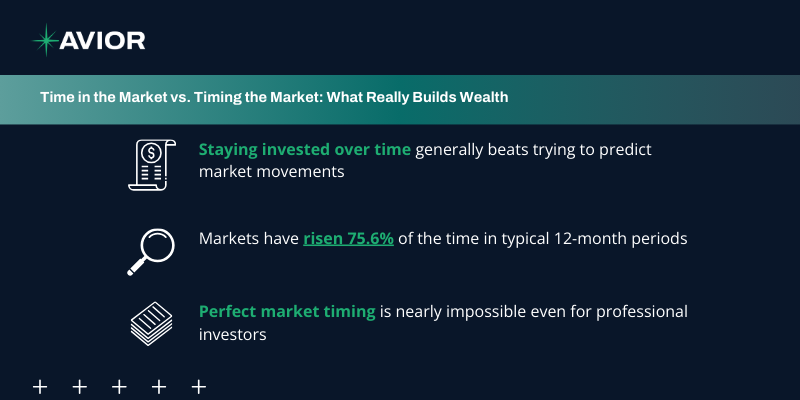Time in the Market vs. Timing the Market: What Really Builds Wealth

Your neighbor won’t stop talking about the stock that doubled after he bought it.
Meanwhile, your investment portfolio grows steadily without fanfare. Who’s really winning here?
Everyone loves a good story about perfect timing. The investor who sold everything before the 2008 crash.
The genius who bought tech stocks at rock bottom during the pandemic.
These tales capture our imagination because they promise a shortcut to wealth.
But here’s what these stories don’t tell you: for every lucky timer, countless others missed the mark entirely. The real wealth builders? They’re the ones who stayed put through thick and thin.
Key Takeaways
- Staying invested over time generally beats trying to predict market movements
- Markets have risen 75.6% of the time in typical 12-month periods
- Perfect market timing is nearly impossible even for professional investors
- Missing just the best market days can cut returns in half
- Dollar-cost averaging helps smooth out market volatility without timing pressure
- Long-term investing reduces the impact of short-term market swings
What These Strategies Actually Mean
Time in the market means staying invested for long periods, regardless of market ups and downs. Think of it like planting a tree – you don’t dig it up every time the weather changes. You water it consistently and let time do the heavy lifting.
Market timing attempts to buy low and sell high by predicting when markets will move. It’s like trying to catch lightning in a bottle – theoretically possible, but practically very difficult.
The difference seems small, but the results can be huge. One approach accepts that markets fluctuate while focusing on long-term growth. The other bets everything on being right about future market movements.
The Numbers Don’t Lie
Let’s look at what actually happens when investors try different approaches. Charles Schwab studied five hypothetical investors over 20 years, each receiving $2,000 annually to invest.
The results were eye-opening. The “perfect timer” who invested at each year’s lowest point ended up with the most money – no surprise there. But the investor who simply put money in on January 1st each year came in a close second. The difference? Just a few percentage points over two decades.
The real loser? The person who kept waiting for the “perfect” moment and never invested at all.
They ended up with far less than everyone else, proving that time beats timing almost every time.
Even more important: the worst possible timer – someone who invested at market peaks each year – still beat keeping money in cash.
This shows how powerful staying invested can be, even with terrible timing.
Why Perfect Timing Fails
Human Psychology Works Against Us
Our brains aren’t wired for investing success. We feel losses twice as strongly as gains, making us want to sell when markets drop and buy when they’re rising.
This emotional rollercoaster leads to buying high and selling low – the exact opposite of what builds wealth.
Fear keeps us on the sidelines during the best buying opportunities. Greed makes us jump in when prices are already stretched.
These natural reactions destroy returns faster than any market crash.
Markets Move When You Least Expect It
The best market days often come right after the worst ones. In 2020, markets crashed in March but recovered to new highs by July. Investors who sold in panic missed the entire recovery.
Seventy-eight percent of the stock market’s best days have occurred during bear markets or in the first two months of bull markets.
This pattern repeats throughout history. The 2008 financial crisis saw markets rebound swiftly once the worst passed.
COVID-19 triggered one of the shortest bear markets on record, catching timers off guard.
Even Experts Get It Wrong
Professional forecasters with teams of analysts and sophisticated models consistently miss the mark. Many expert predictions by the end of 2022 found that none came close to the actual S&P 500 gain of 24.2% in 2023. Some predictions were off by 28%.
If the pros can’t time markets reliably, what chance do individual investors have?
The answer: very little. This is why even institutional investors increasingly favor time-based strategies over timing-based ones.
The Power of Staying Invested
Compound Growth Needs Time
Money grows exponentially when left alone to compound.
A $10,000 investment growing at 8% annually becomes $21,589 after 10 years. But pull it out and put it back in repeatedly, and you interrupt this compounding magic.
Every time you sell and wait to reinvest, you lose potential growth days. Miss just 10 of the best market days over 30 years, and your returns get cut in half.
This math alone makes staying invested the smarter choice.
Dollar-Cost Averaging Smooths the Ride
Regular investing through dollar-cost averaging removes timing pressure entirely. Instead of trying to pick perfect entry points, you buy more shares when prices are low and fewer when they’re high.
This natural rebalancing often leads to better average prices over time.
Many investors already practice this through 401(k) contributions without realizing it. Each paycheck, money flows into investments regardless of market conditions.
This steady approach has helped millions build retirement wealth without any timing skill required.
Real-World Examples
The 2008 Financial Crisis
Imagine you had terrible timing and invested everything at the market peak in 2007, right before the crash. It would have felt awful watching your portfolio drop 37% the next year.
But if you stayed invested, you would have recovered by 2013 and gone on to significant gains.
Investors who panicked and sold at the bottom locked in those losses forever. They missed the recovery that followed, turning a temporary setback into permanent damage.
The COVID-19 Pandemic
March 2020 saw markets fall faster than they had since 1987. Headlines screamed about economic disaster. Many investors fled to cash, certain that worse was coming.
But markets recovered within four months. By 2021, they hit new all-time highs. Investors who stayed the course not only recovered their losses but achieved strong gains.
Those who sold and waited for clarity missed most of the rebound.
Common Timing Mistakes to Avoid
Trying to Catch Falling Knives
When markets crash, it’s tempting to try catching the exact bottom. But falling markets can keep falling longer than you expect.
Instead of trying to time the perfect entry, consider gradually increasing investments during downturns.
Following the Crowd
When everyone is talking about how great the market is, it’s often near a peak.
When doom and gloom dominate headlines, opportunities may be emerging. Contrarian thinking helps, but timing based on sentiment alone rarely works.
Overthinking Short-Term Moves
Daily market movements are mostly random noise. Trying to react to every headline or economic report leads to overtrading and poor results.
Focus on your long-term goals instead of short-term market chatter.
Building Your Time-Based Strategy
Start With Clear Goals
Define what you’re investing for and when you’ll need the money. This timeline determines how much volatility you can handle and what investments make sense.
Retirement funds can handle more ups and downs than money needed in two years.
Automate Your Investing
Set up automatic transfers to remove emotion from the equation. When investing happens automatically, you can’t second-guess yourself or try to time the market.
This simple step eliminates many behavioral mistakes.
Focus on Diversification
Spread your investments across different asset types and geographies. This reduces the impact of any single investment going wrong and provides steadier overall returns.
Diversification works better than timing for managing risk.
Rebalance Periodically
Review your portfolio annually and rebalance if needed. This forces you to sell high-performing assets and buy underperforming ones – the opposite of what emotions tell you to do.
It’s a disciplined way to buy low and sell high without trying to time markets.
Work With Us
The evidence is clear: time in the market consistently beats timing the market for building real wealth.
While perfect timing makes for exciting stories, staying invested through market cycles is what actually makes people rich. The S&P 500’s 23% gain in 2024 rewards investors who stayed the course, just as it has for decades of patient wealth builders.
At Avior, we help clients build wealth through disciplined, long-term strategies rather than market timing gambles.
Our approach focuses on your unique goals and timeline, creating investment plans designed to grow your wealth steadily over time. If you’re ready to stop trying to time the market and start building lasting wealth, we’re here to help you create a strategy that works. Contact Avior today to learn how time-based investing can transform your financial future.
No Comments
Sorry, the comment form is closed at this time.




